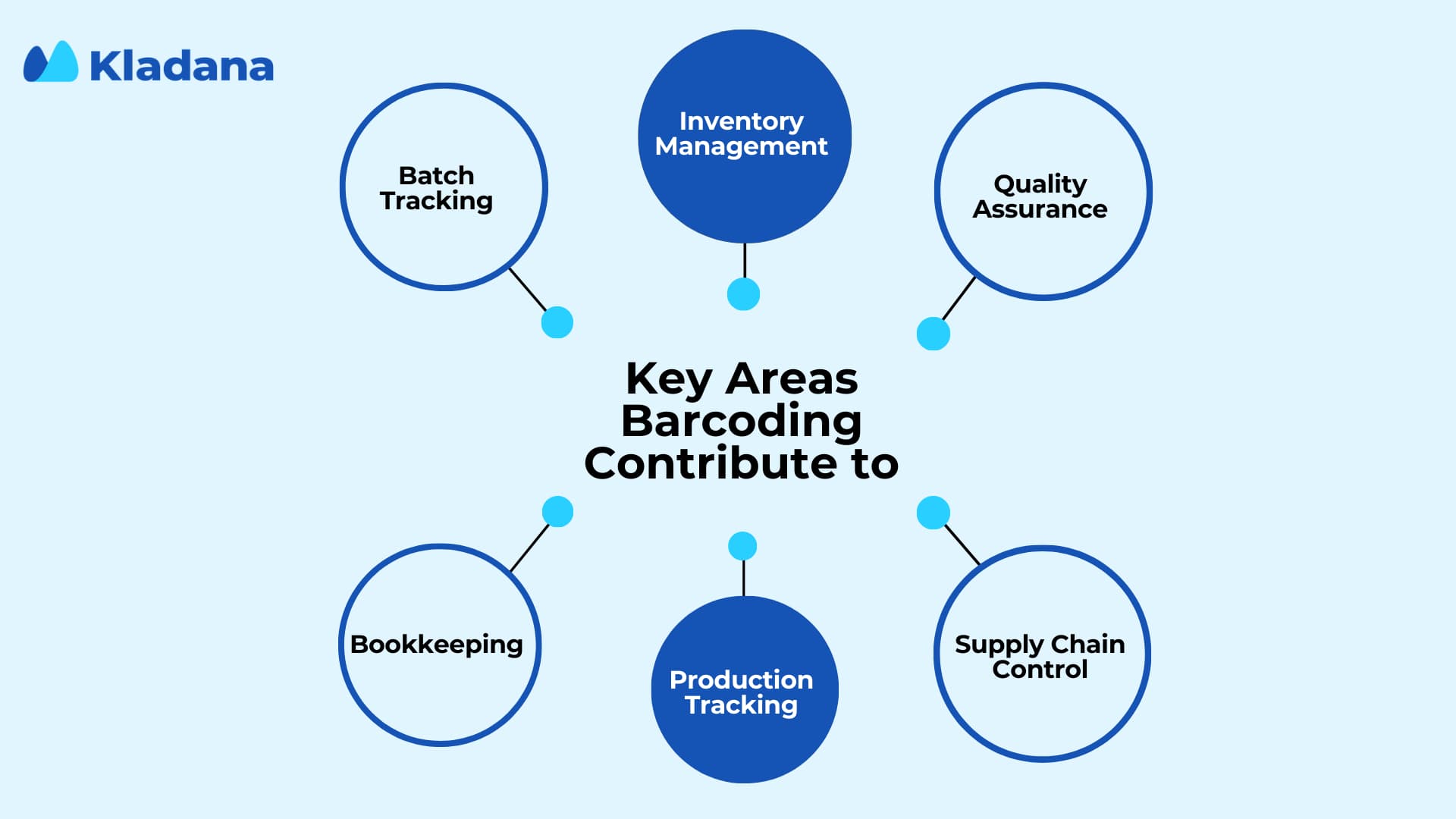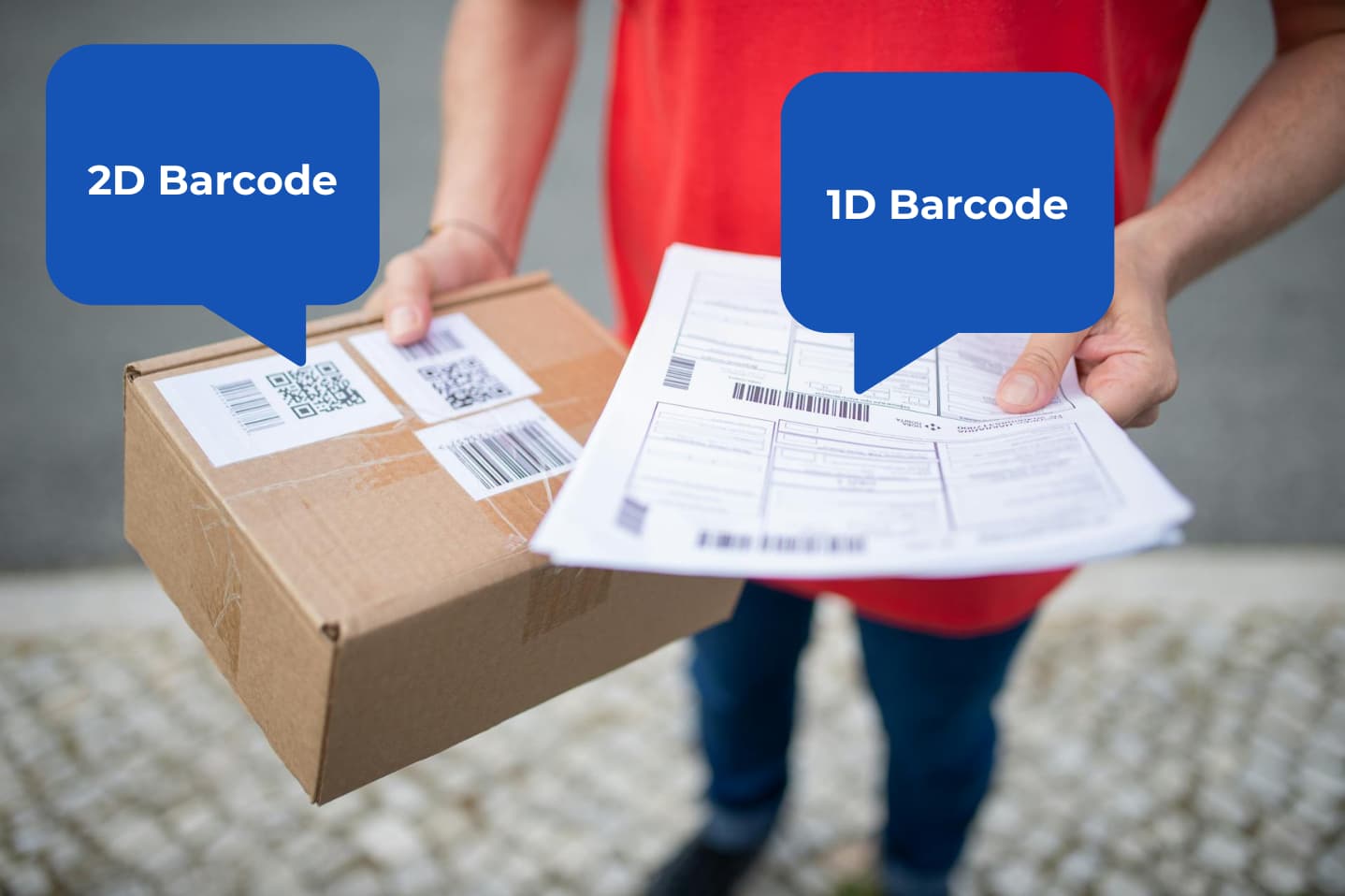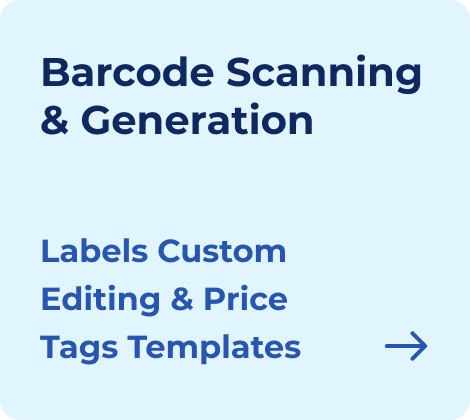Let’s compare the two processes: labeling every box of products by hand and marking boxes with barcode stickers. Which one is more time- and labor‑consuming?
But there’s more. When it comes time to decode the labels, handwritten labels require a notebook to track all the codes. But wait… where is it? With barcoding, all you need is a scanner that provides instant information about the product.
Let’s dive into the world of barcoding for manufacturers to see how easy it is to implement and what benefits it can bring.
How Are Barcodes Used for Manufacturing Businesses?
Barcoding is an unalienable part of managing manufacturing processes though it may seem distant from the things happening in manufacturing facilities. Here we’ll list the key areas of barcode application.
Inventory Management
Barcoding significantly enhances inventory management by automating various tasks and providing real‑time data on stock levels. Each product is assigned a unique barcode that allows quick and accurate tracking of its movement within the facility. This system can speed up receiving materials, identifying all types of inventory, and shipping deliveries.
You can instantly update inventory counts without manual adjustments. You only need to scan the barcode. This streamlined process helps businesses make informed purchasing decisions, minimizing the risk of human errors, stockouts, or excess inventory. Discover how to implement an effective barcoding system in your warehouse by reading our article.
Batch Tracking
This area is worth a dedicated mention because tracking the batch can sometimes become an impossible task. Barcoding allows you to get the full information about the parts that are used in manufacturing by simple and fast scanning.
This can be particularly useful in cases where you need to investigate the reason for a product return or to trace batch‑related defects of your product to issue a recall for certain items.
Quality Assurance
It’s impossible to get rid of every mistake that can emerge during the manufacturing process. Automation will help you to reduce the risk of errors. The barcoding system allows you to correctly identify the information about the item’s details, terms and dates of manufacture, batches, etc. This helps to trace quality issues and make fast well‑grounded decisions on combating defects.
Bookkeeping
Barcoding can be used not only for inventory items such as raw materials, semi‑finished, and finished products. You can also boost your bookkeeping processes by introducing barcodes to various documents that accompany your manufacturing processes.
Automated entry of the data from invoices, purchase orders, contracts, etc. allows you to avoid tedious paperwork and save a considerable amount of time.
Supply Chain Control
A properly introduced barcoding system can enhance your supply chain traceability. It allows control of the movement of products at every stage from raw materials suppliers to the customers of the products. It gives the possibility to make planning, reporting, and whole supply chain management more efficient.
Production Tracking
Barcodes allow manufacturers to monitor the movement of products through every phase of production. By scanning barcodes at different stages, you can track production speeds, spot delays, and improve efficiency.

Why Is It Important to Use Barcodes in the Manufacturing Process?
Using barcodes in manufacturing offers numerous benefits that streamline operations and enhance productivity. Let’s consider the most important of these advantages:
Improved Accuracy
Barcodes significantly reduce human error in data entry. By scanning items instead of manually inputting data, you ensure more accurate tracking of inventory and materials.
Dramatic Time Saving
Barcodes speed up the process of inventory management. Scanning barcodes is much faster than typing codes, allowing employees to complete tasks more quickly and efficiently.
Better Inventory Management
Barcodes provide real‑time inventory updates, helping manufacturers keep track of stock levels accurately. This leads to better inventory control and minimizes overstocking or stockouts.
Cost Savings
Reducing errors and increasing efficiency translates to cost savings. Barcodes help cut labor costs and waste, contributing to a more cost‑effective manufacturing process.
Simplified Data Collection
Barcodes make it easy to collect and store data for analysis. This data can be used to improve processes, forecast demand, and make weighted business decisions.
Enhanced Traceability
Barcodes enable manufacturers to trace products throughout the supply chain. This is crucial for quality control, recalls, and ensuring compliance with industry standards.
Improved Collaboration Between Departments
Barcodes facilitate better communication and coordination between different departments. Real‑time data sharing ensures that production, inventory, and shipping departments are always on the same page.
Improved Customer Satisfaction
With accurate inventory and efficient processes, manufacturers can fulfill orders more reliably and promptly, leading to higher customer satisfaction.
Advantages of Kladana for Manufacturers
✅ Streamline Operations
Integrate all processes from warehouse management to delivery.
✅ Real‑Time Data
Access up‑to‑date information for informed decision‑making.
✅ Boost Efficiency
Automate tasks to save time and reduce errors.
✅ Improve Inventory Management
Optimize stock levels and reduce waste.
✅ Scalable Solutions
Adapt to your growing business needs.
✅ Cost Savings
Reduce operational costs with efficient resource management.
What Types of Barcodes Are Most Suitable for Manufacturing?
Both linear (1D) and 2D barcodes can be successfully used in manufacturing. The first type provides simplicity and speed, while the second offers comprehensive data storage and flexibility. Let’s list the most common barcode examples and give their description:
Linear (1D) Barcodes
- Examples: UPC, Code 128, ITF 14
- Features: Simple, efficient, easy to scan
- Uses: Tracking inventory and raw materials, integration into existing systems
- Details: 1D barcodes are ideal for applications requiring quick and reliable scanning. They can be read by most barcode scanners and are commonly found on packaging, making them versatile and widely accepted in the industry.
- Appearance: Linear barcodes consist of parallel lines and spaces of varying widths, usually with a series of numbers or characters printed underneath.
To get more detailed information about the barcoding systems, types of barcodes, barcoding equipment, and software, check out our article:
Barcode Inventory Solutions 2025: Top 12 Software Tools for Managing Your Business
2D Barcodes
- Examples: QR codes, Data Matrix
- Features: Greater data storage capacity, compact size
- Uses: Holding batch numbers, expiry dates, serial numbers; detailed tracking and quality control
- Details: 2D barcodes can store significantly more information than linear barcodes, which is beneficial for manufacturers needing to encode extensive data in a small space. They can be scanned from any direction, improving scan efficiency and reducing errors.
- Appearance: 2D barcodes are composed of patterns of squares, dots, and other shapes within a square or rectangular grid, allowing them to hold large amounts of data in a compact form.

How to Implement a Barcode System in Manufacturing?
You should understand that the introduction of a barcode system is not a one‑day activity. You’ll have to undergo several stages but if you do everything right the result will definitely satisfy you. Here’s a step‑by‑step guide to get you started:
Assess Your Needs
Identify which processes will benefit the most from barcoding. This could include inventory management, production tracking, supply chain control, etc.
Choose the Right Barcode Type
Select the barcode format that suits your needs. The most common types include UPC, QR codes, and Data Matrix.
Select Barcode Software
Invest in reliable barcode software that integrates with your existing systems. Ensure it supports your required barcode formats and offers customization options.
Try barcode generating and scanning possibilities in Kladana:
- GTIN, EAN‑13, EAN‑8, Code‑128, and UPC barcodes for manufacturers and wholesalers
- Easy import, generation, and autogeneration with just a few clicks
- Scanning capabilities for receiving, shipping, transfers, and stock‑taking
- Templates for thermal labels and price tags
- Customizable label editing
Acquire Barcode Equipment
Choose barcode scanners that are compatible with your barcode software and durable enough for your manufacturing environment. Don’t forget about the barcode printers, labels, and ribbons.
Design and Print Barcodes
Use your software to design barcodes and print them on labels. Ensure they are clear and scannable.
Label Your Inventory
Attach barcode labels to all relevant items, including raw materials, work‑in‑progress items, and finished goods.
Train Your Staff
Provide comprehensive training for employees on how to use the barcode system, including scanning procedures and troubleshooting.
Test the System
Conduct a thorough test of the barcode system to ensure everything works seamlessly. Make any necessary adjustments.
Go Live
Implement the system fully across your manufacturing operations. Monitor its performance and gather feedback for continuous improvement.
Frequently Asked Questions on Barcoding for Manufacturers
For manufacturers considering barcoding, it’s common to have questions about its implementation, benefits, and best practices. Below, we’ve addressed some of the most frequently asked questions to help you get started.
Why is barcoding important for manufacturers?
Barcoding enhances accuracy and efficiency in inventory management, reducing human errors, speeding up the tracking process, and improving overall productivity.
How does barcoding improve inventory management?
Barcoding provides real‑time data on inventory levels, locations, and movements, allowing manufacturers to keep precise track of stock and reduce the chances of overstocking or stockouts.
What types of barcodes are commonly used in manufacturing?
Common types include UPC (Universal Product Code), EAN (European Article Number), and Code 39. Each serves different needs based on the product and region.
How can manufacturers implement a barcoding system?
Manufacturers need to choose suitable barcode software, hardware (scanners, printers), and labels. Training staff on how to use the system is also crucial.
Are there any standards for barcoding?
Yes, there are international standards like GS1, which ensures that barcodes are unique and can be used globally, facilitating international trade and logistics.
What are the costs associated with implementing a barcoding system?
Costs can include purchasing barcode printers, scanners, software, and labels, as well as training employees. The investment often pays off through increased efficiency and reduced errors.
Can barcodes be used in all manufacturing industries?
Yes, barcodes are versatile and can be used in various industries, from automotive and electronics to food and pharmaceuticals, to track and manage products.
What are the benefits of integrating barcoding with ERP systems?
Integrating barcoding with ERP systems enhances data accuracy, streamlines operations, and provides real‑time insights into inventory and production processes.
How can barcoding help with regulatory compliance?
Barcoding helps manufacturers comply with regulations by ensuring accurate record‑keeping, traceability of products, and efficient recall processes if needed.
What are the common challenges when implementing barcoding in manufacturing?
Challenges include the initial setup costs, training employees, ensuring system integration, and maintaining the equipment. Proper planning and support can mitigate these challenges.
How can manufacturers ensure the durability of barcodes?
Using high‑quality labels and printers, choosing the right type of barcode for the environment, and ensuring proper application can help maintain barcode readability and durability.


